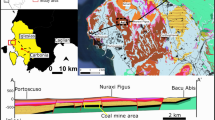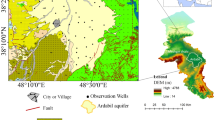Abstract
The ground subsidence induced by salt mining has been causing significant damage in Tuzla, Bosnia and Herzegovina since the 1950s. Several investigations and geodetic surveys have been conducted, i.e., traditional topographic surveys (1950–2003) and static GPS surveys (2004–2007). The last GPS survey (2006–2007) revealed that the subsidence in Tuzla was still occurring at a rate of about − 10 cm/year in some areas. Although monitoring of the subsidence has been on-going at a few points since 2010, by means of the real-time kinematic GNSS method, it lacks spatial coverage. Therefore, an appropriate method is required to monitor the subsidence over an extensive area at a low cost and with less labor time. Differential Interferometry Synthetic Aperture Radar (DInSAR), together with the Small Baseline Subset (SBAS) time-series algorithm, is one of the solutions for use as an effective monitoring tool. The spatial distribution of the subsidence obtained by SBAS-DInSAR shows a good agreement with the subsidence obtained from the former monitoring results. The temporal transition of the subsidence obtained by SBAS-DInSAR is evaluated using the results by the real-time kinematic GNSS monitoring system. It was shown that the DInSAR results coincide with the GNSS results with a discrepancy of less than 10 mm. SBAS-DInSAR detected that the subsidence had almost vanished everywhere, except the north and northeast portions of Pannonica Lake where the rate of subsidence was − 1 to − 4 cm/year during the period of October 2014–May 2019. This study demonstrates that SBAS-DInSAR can be employed as a useful and effective subsidence monitoring tool without the need to install any devices in the monitoring area.

(modified from Mancini et al. 2009a)










modified from Mancini et al. 2009b), b subsidence obtained by SBAS-DInSAR October 9, 2014 to May 28, 2019, c section A–A’, d section B–B’, e section C–C’, and f section D–D’


Similar content being viewed by others
Abbreviations
- AW3D30:
-
ALOS World 3D—30-m resolution digital elevation model
- DEM:
-
Digital Elevation Model
- DInSAR:
-
Differential Interferometry Synthetic Aperture Radar
- GIS:
-
Geographic Information System
- GNSS:
-
Global Navigation Satellite System
- GPS:
-
Global Positioning System
- InSAR:
-
Interferometry Synthetic Aperture Radar
- JAXA:
-
Japan Aerospace Exploration Agency
- LOS:
-
Line of Sight
- SAR:
-
Synthetic Aperture Radar
- SBAS:
-
Small Baseline Subset
- \(\lambda\) :
-
Wavelength
- \(\theta_{0}\) :
-
Off-nadir angle
- \(\theta_{i}\) :
-
Incidence angle
- \(\beta\) :
-
Angle of the satellite flight (orbit) direction
- \(D_{{{\text{sub}}}}\) :
-
Subsidence
- \(D_{{{\text{LOS}}}}\) :
-
Displacement along satellite’s line of sight (LOS)
- \(D_{{{\text{N}} - {\text{S}}}}\) :
-
Displacement in North–South direction
- \(D_{{{\text{E}} - {\text{W}}}}\) :
-
Displacement in East–West direction
- \(D_{{{\text{U}} - {\text{P}}}}\) :
-
Displacement in Up–Down (vertical) direction
References
Bakalović M (2005) The City on a Grain of Salt. Historical Technical Brochure. The Museum of Eastern Bosnia, Tuzla
Barla G (2018) Numerical modeling of deep-seated landslides interacting with man-made structures. J Rock Mech Geotech Eng 10:1020–1036
Berardino P, Fornaro G, Lanari R, Sansosti E (2002) A new algorithm for surface deformation monitoring based on small baseline differential SAR interferograms. IEEE Int Geosci Rem Sens Symp 40:2375–2383. https://doi.org/10.1109/TGRS.2002.803792
Casu F, Manzo M, Lanari R (2006) Mapping ground deformation over Houston-Galveston, Texas using multi-temporal InSAR. Rem Sens Environ 102:195–210
Čeliković R, Imamović E (2016) Continuous GNSS movement monitoring in the zone of influence of Tuzla salt deposit. Int Symp Eng Geodesy 2016:489–498
Čeliković R, Imamović E, Salihović R, Sušić A (2014) Prostorno vremenska analiza vertikalnih pomjeranja terena u Tuzli za period 2008–2012. Proc GEO-EXPO. https://doi.org/10.35123/GEO-EXPO_2014_6
Ciantia MO, Castellanza R, Fernandez-Merodo JA (2018) A 3D numerical approach to assess the temporal evolution of settlement damage to buildings on cavities subject to weathering. Rock Mech Rock Eng 51:2839–2862
Cicić S (2002) Geological composition and tectonic terrain of Bosnia and Herzegovina (in Bosnian). In: Hrvatović H (ed) Geological guidebook through Bosnia and Herzegovina. Geological Survey of Bosnia and Herzegovina Federation, Ustanicka, pp 111–116
Ferhatbegović Z (2004) Geological features of the central part of the Tuzla basin. In: Dissertation, Faculty of Mining and Geology and Civil Engineering, University of Tuzla
Ferretti A (2014) Satellite InSAR data: reservoir monitoring from space. EAGE Publication, The Netherlands
Ferretti A, Prati C, Rocca F (2000) Nonlinear subsidence rate estimation using permanent scatterers in differential SAR interferometry. IEEE Trans Geosci Rem Sens 38:2202–2212. https://doi.org/10.1109/36.868878
Ferretti A, Monti-Guarnieri A, Prati C, Rocca F, Massonnet D (2007) InSAR principles: guidelines for SAR Interferometry Processing And Interpretation. ESA Publications, The Netherlands
Herrera G, Tomas R, Vicente F, Lopez-Sanchez JM, Mallorqui JJ, Mulas J (2010) Mapping ground movements in open pit mining areas using differential SAR interferometry. Int J Rock Mech Min Sci 47:1114–1125
Hrvatović H (2006) Geological guidebook through Bosnia and Herzegovina. Geological Survey of Bosnia Herzegovina Federation, Ustanicka
Hu L, Dai K, Xing C, Li Z, Tomás R, Clark B, Shi X, Chen M, Zhang R, Qiu Q, Lu Y (2019) Land subsidence in Beijing and its relationship with geological faults revealed by Sentinel-1 InSAR observations. Int J Appl Earth Obs Geoinf 82:101886–101896
Ibreljić I, Kudumović F, Ahmetbegović S (2007) Economy and ecology of natural resources in Tuzla area (Bosnia and Herzegovina) in the past and future projections. In: Proceedings of the “Joint Congress of the European Regional Science Association and ASRDLF (Association de Science Regionale de Langue Francaise), Paris, pp 1–7
Janna C, Castelletto N, Ferronato M, Gambolati G, Teatini P (2012) A geomechanical transversely isotropic model of the Po River basin using PSInSAR derived horizontal displacement. Int J Rock Mech Min Sci 51:105–118
Jokanovic B (1952) Zbornik radova, Tehnicka skola u Beogradu, pp 107–118
Jovanovic P (1968) Contribution to the knowledge of genesis of rock salt deposits. Tuzla Bull Geol 13:311–317
Jovanović O (1980) Genesis of Pretortonian Miocene sediments in North Bosnia, between Una and Orina River (in Serbian). Geoloski Glasnik 16:33–40
Katzer F (1903) Historijsko rasvijanje i danasnje stanje geoloskog proucavanja Bosne I Hercegovine. Glas.zem. muz. BiH. Sep. otis Sarajevo
Lanari R, Casu F, Manzo M, Zeni G, Berardino P, Manunta M, Pepe A (2007) An overview of the small baseline subset algorithm: A DInSAR technique for surface deformation analysis. Pure Appl Geophys 164:637–661. https://doi.org/10.1007/s00024-007-0192-9
Mancini F, Stecchi F, Gabbianelli G (2009a) GIS-based assessment of risk due to salt mining activities at Tuzla (Bosnia and Herzegovina). Eng Geol 109:170–182. https://doi.org/10.1016/j.enggeo.2009.06.018
Mancini F, Stecchi F, Zanni M, Gabbianelli G (2009b) Monitoring ground subsidence induced by salt mining in the city of Tuzla (Bosnia and Herzegovina). Environ Geol 58:381–389. https://doi.org/10.1007/s00254-008-1597-1
Motagh M, Shamshiri R, Haghighi MH, Wetzel H-U, Akbari B, Nahavandchi H, Roessner S, Arabi S (2017) Quantifying groundwater exploitation induced subsidence in the Rafsanjan plain, southeastern Iran, using InSAR time-series and in situ measurements. Eng Geol 218:134–151
Piane LD, Perello P, Baietto A, Giorza A, Musso A, Gabriele P, Baster I (2016) Mature vs. active deep-seated landslides: a comparison through two case histories in the Alps. Rock Mech Rock Eng 49:2189–2216
Qu F, Lu Z, Zhang Q, Bawden GW, Kim J-W, Zhao C, Qu W (2015) Mapping ground deformation over Houston-Galveston, Texas using multi-temporal InSAR. Rem Sens Environ 169:290–306
Rutqvist J, Rinaldi AP, Cappa F, Jeanne P, Mazzoldi A, Urpi L, Guglielmi Y, Vilarrasa V (2016) Fault activation and induced seismicity in geological carbon storage and lessons learned from recent modeling studies. J Rock Mech Geotech Eng 8:789–804
SARMAP (2019) ENVI SARscape 5.5 Release Notes. Harris Geospatial Solution. https://www.sarmap.ch/5.5/SARscape_Release_Notes_552.pdf
Soklić I (1959) Miocene paleogeography and origin of salt deposits in Tuzla (in Croatian). In: Hrvatović H (ed) Geological Guidebook through Bosnia and Herzegovina. Geological Survey of Bosnia and Herzegovina Federation, Ustanicka, Sarajevo, pp 117–124
Soklić I (1964) Origin and structures of the Tuzla basin. Geol Glasnik 1:11–18
Soklić I (1982) Stratigraphy and age of salt formations in Tuzla (in Croatian), Radevi AnuBiH. Odj teh Nauka 7:135–151
Stecchi F (2008) Tuzla City (BIH): An example of geohazard induced by salt extraction. Dissertation, Alma, University of Bologna. https://doi.org/10.6092/unibo/amsdottorato/1033
Stecchi F, Antonellini M, Gabbianelli G (2009) Curvature analysis as a tool for subsidence-related risk zones identification in the city of Tuzla (BiH). Geomorphology 107:316–325. https://doi.org/10.1016/j.geomorph.2008.12.013
Stevanović P (1977) Geology of the Bosnia and Herzegovina, Book 3—Cenozoic periods. In: Hrvatović H (ed) Geological Guidebook through Bosnia and Herzegovina. Geological Survey of Bosnia and Herzegovina Federation, Ustanicka, pp 187–216
Takaku J, Tadono T (2017) Quality updates of ‘AW3D’ global DSM generated from ALOS PRISM. IEEE Int Geosci Rem Sens Symp (IGARSS). https://doi.org/10.1109/IGARSS.2017.8128293
Tari V, Pamić J (1998) Geodynamic evolution of the northern Dinarides and the southern part of the Pannonian Basin. Tectonophysics 297:269–281
Tizzani P, Berardino P, Casu F, Euillades P, Manzo M, Ricciardi GP, Zeni G, Lanari R (2007) Surface deformation of Long Valley caldera and Mono Basin, California, investigated with the SBAS-InSAR approach. Rem Sens Environ 108:277–289
Tomić B, Nurić A, Nuhanović S (2005) Ground subsidence above the flooded "Tušanj" salt mine, Rudarstvo, ISSN 0353-9172 UDC 622
Vervoort A, Declercq PY (2018) Upward surface movement above deep coal mines after closure and flooding of underground workings. Int J Min Sci Technol 28:53–59
Vrabac S (1999) Facial and biostratigraphic characteristics of Badenian and Sarmatian in North Bosnia (in Bosnian), Tuzla. In: Hrvatović H (ed) Geological Guidebook through Bosnia and Herzegovina. Geological Survey of Bosnia and Herzegovina Federation, Ustanicka, pp 67–82
Vrabac S (2005) Istorijska geologija. University of Tuzla, pp 1–213
Wempen JM, McCrater MK (2017) Comparison of L-band and X-band differential interferometric synthetic aperture radar for mine subsidence monitoring in central Utah. Int J Min Sci Technol 27:159–163
Woo KS, Eberhardt E, Rabus B, Stead D, Vyazmensky A (2012) Integration of field characterisation, mine production and InSAR monitoring data to constrain and calibrate 3-D numerical modelling of block caving-induced subsidence. Int J Rock Mech Min Sci 53:166–178
Zan FD, Guarnieri AM (2006) TOPSAR: terrain observation by progressive scans. IEEE Trans Geosci Remote Sens 44:2352–2360. https://doi.org/10.1109/TGRS.2006.873853
Acknowledgements
This research was partially supported by JSPS KAKENHI (Grant-in-Aid for Scientific Research, Japan Society for the Promotion of Science) Grant no. 16H03153 and the International Collaborative Research Fund of Yamaguchi University. The SAR data were provided by the European Space Agency (ESA) and are distributed for free through the Copernicus program. The digital elevation model (DEM) and ALOS Global Digital Surface Model "ALOS World 3D-30m (AW3D30)” were provided by the Japan Aerospace Exploration Agency (JAXA). The authors wish to express their appreciation to those agencies. They also extend their appreciation to Tuzla City Municipality for their encouragement, Professor Z. Ferhatbegović for his suggestions regarding the description of geological features in Tuzla, and H. Griswold for proofreading the manuscript.
Author information
Authors and Affiliations
Corresponding author
Ethics declarations
Conflict of interest
The authors wish to confirm that there are no known conflicts of interest associated with this publication and there has been no significant financial support for this work that could have influenced its outcome.
Additional information
Publisher's Note
Springer Nature remains neutral with regard to jurisdictional claims in published maps and institutional affiliations.
Rights and permissions
About this article
Cite this article
Parwata, I.N.S., Shimizu, N., Grujić, B. et al. Monitoring the Subsidence Induced by Salt Mining in Tuzla, Bosnia and Herzegovina by SBAS-DInSAR Method. Rock Mech Rock Eng 53, 5155–5175 (2020). https://doi.org/10.1007/s00603-020-02212-1
Received:
Accepted:
Published:
Issue Date:
DOI: https://doi.org/10.1007/s00603-020-02212-1







